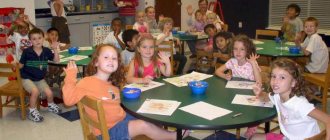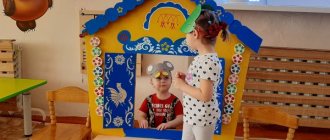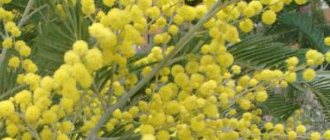Lesson 3. Sound culture of speech: the sound o. Looking at illustrations for the fairy tale “Kolobok”
Target. Continue to teach children to carefully look at pictures in books and explain the contents of the illustrations. Practice clear pronunciation of the sound o.
Progress of the lesson
Part I. “The tongue sang for a long time and with pleasure the song of a baby who does not yet know how to speak, but only pronounces the sound a
(a-a-a), - the teacher begins the lesson. – I didn’t forget the tongue and the song of the locomotive. Do you remember this song? (Children's answers.)
And now Tongue tells everyone how a girl whose ear hurt was moaning and wailing. And she moaned like this: “Oh-oh-oh.” Can you do this? (Choral and several individual responses.)
When a person - an adult or a child - is happy or surprised by something, he may exclaim: “Oh!” Can you repeat that? (Chorus and several individual answers.) And when one of you falls and hurts his knee, he will definitely say: “Oh!” (Choral and individual repetitions.)
The teacher offers to play. Taking on the role of the bun, he approaches the child and says: “The bun is rolling along the road, and a hare meets him.” The child continues: “Kolobok, Kolobok!” I will eat you!"
Next, the teacher, portraying a bun, meets a wolf and a bear, who also claim that they will eat him.
Part II. The teacher briefly talks about how carefully the children looked at the drawings for the fairy tale “Kolobok”.
“Ole,” says the teacher, “liked the drawing by Yu. Vasnetsov (it is advisable to name the artist). Olya described it this way... (the child’s answer is heard and supplemented if necessary).
Andryusha liked the drawing by A. Eliseev (shows). Tell about him.
And almost all the children liked this drawing. (Shows him.) Why? (Children's statements.)
I am glad that you are not just leafing through books, but also looking at the drawings. In your favorite drawing, I also noticed... (describes the illustration).
“I will leave these books in the group,” the teacher concludes the lesson, “and if you notice something interesting in the picture(s), be sure to show me.”
Lesson 4. Reading A. Blok’s poem “Bunny”. Memorizing A. Pleshcheev’s poem “Autumn has come...”
Target. Help children remember A. Pleshcheev’s poem “Autumn has come.” When perceiving A. Blok’s poem “Bunny,” evoke sympathy for the little bunny, who is cold, hungry and scared in the uncomfortable autumn season.
Preliminary work. During a walk, the teacher looks at the flowers in the flower beds with the children (the flowers are dry),
bushes with fallen leaves
(bare bushes).
Progress of the lesson
Part I. The teacher invites the children to memorize the poem “Autumn has come” by Alexei Nikolaevich Pleshcheev. (It is imperative to name the authors of the works, without requiring children to remember their last names.)
The teacher reads a poem. Then he finds out whether it is true that it reflects the signs of autumn: “The flowers... (dried up).
“The bushes...
(bare).
The sun...
(does not shine).
Rain...
(drizzle).
The teacher reads the poem again, asking the children to finish the words without straining their voices.
With the help of the children, the teacher reads the poem for the third time.
The teacher invites the child to his place, hands him a beautiful autumn leaf and asks him to read a poem. Some children over 3 years 6 months read all eight lines, while younger children read the first four lines.
After reading the poem, the child passes the piece of paper to another child (whoever he wants), inviting him to also read the poem. (Choosing a peer is a pleasant moment for both children.)
The teacher calls 2-3 children. In the following days, he helps read the poem to other kids.
“In autumn, when “clouds cover the sky,” it’s drizzling, the street is damp, dirty, cold,” the teacher continues, “it’s bad for both people and animals. It’s especially bad for a tiny bunny.”
Part II. The teacher reads A. Blok’s poem “Bunny”.
If only it were warmer, If only it were drier... It’s very unpleasant to step on water!
After reading, the teacher asks the children if they feel sorry for the little bunny.
Note.
At the request of the teacher, instead of A. Pleshcheev’s poem, you can offer children to memorize A. Koltsov’s poem “Faith Blows, Wild Winds...”.
The winds are blowing, the winds are violent, the clouds are moving, the clouds are dark. You can’t see the white Light in them; You can't see the red Sun in them.
Both poems should be read repeatedly to children while walking, correlating them with the features of an autumn day.
November
Lesson 1. Reading poems about autumn. Didactic exercise “What comes out of what”
Target. Introduce children to poetry, develop a poetic ear. Practice forming words by analogy.
Progress of the lesson
Part I. “Now it’s outside... (autumn) -
The teacher starts the lesson. – Autumn, especially early autumn, when all the leaves on the trees turn yellow, red, burgundy, is a beautiful time of year.
But this is also a sad time of year, as in the fall it becomes cold, rainy, and dirty.
Poets talk very interestingly and beautifully about autumn (those who write poetry are called poets). Listen."
The teacher reads K. Balmont’s poem “Autumn”, then repeats some lines reflecting the signs of autumn: “The lingonberries are ripe, the days have become... (colder)”,
“All the trees shine in a multi-colored dress...”, “The sun laughs less often...”, etc.
“Remember the poem about a bunny who is cold and uncomfortable on an autumn day? – the teacher continues the conversation. —
In the autumn, Thin blades of grass burst into tears, Paws step on yellow leaves.”
Which poem should I read to you again: “Autumn” or “Bunny”?” - asks the teacher. (If opinions differ, both poems should be read.)
Part II. “In the fall,” says the teacher, “people harvest vegetables and fruits, make jam and juices. Lingonberries make lingonberry juice, cranberries... (cranberry),
from carrots...
(carrot),
from beets...
(beet),
from pumpkin...
(pumpkin),
and from tomatoes...
(tomato).
Jam is prepared for the winter. For example, I love raspberry jam. It is cooked... (from raspberries).
Apple...
(made from apples).
Blueberry...
(from blueberries).
Blackberry...
(from blackberries).
Apricot...
(from apricots).
Admit it, who likes what kind of jam?” (Repetition of adjectives.)
Note. To consolidate the material, it is advisable to use the task from the workbook “Speech development in children. Junior group" (M.: Mozaika-Sintez, 2006), presented on page 8.
Lesson 2. Sound culture of speech: sound and
Target. Exercise children in clear and correct pronunciation of sounds and
(isolated, in phrases, in words).
Progress of the lesson
The teacher shows the children a cube, on the sides of which a small child, a steam locomotive, a chicken, and a bell are drawn.
“Spin, spin, lie on your side,” says the teacher, manipulating the cube. Shows children a picture, for example, of a steam locomotive. Children remember the sound of a steam locomotive: “Oooh.” The teacher explains: “If the cube turns to the side on which the baby is drawn, you should sing his song: “A-ah-ah,” if the picture shows a chicken, you need to say: “Ko-ko-ko” or “Kwoh-kwoh-kwoh” “. And I’ll tell you more about the bell song.”
Children sit on chairs. The teacher shows them a horse or foal (picture, toy) and asks if they know how a horse screams.
The teacher asks the children to sing a long song: “E-and-and-and.” (Choral and individual repetitions.) The teacher “transforms” some children into foals and “winds them up” with a magic key. Children sing a foal song.
The teacher notes children who do not pronounce sounds clearly in order to later work with them individually (you can do it in front of a large mirror so that your lips are visible).
The teacher shows the children bells, rings them and explains: “The little bells sing: “Li-i-i-li-i-i-li-i-i” (sound and
pronounced drawlingly). How do bells sing? And the bigger bells sing: “Di-i-i-yin-di-i-i-yin.” (Choral and individual repetitions.)
The teacher places a flannelgraph in front of the children. It shows a picture of a sparrow on a black background. “You see,” the teacher explains, “the crocodile swallowed the sun and it became dark and dark.
The gray sparrow cries: “Come out, sunshine, quickly!” We feel sad without the sun - You can’t see a grain in a field!”
The bunnies are crying on the lawn: The poor things have lost their way, They can’t get home.”
The teacher repeats the passage, highlighting the stressed vowels in the words offensive, not visible, lost the way, not getting there.
Then he repeats the quatrains, and the children finish the highlighted words and phrases.
The teacher asks the kids to remember the name of the fairy tale in which the bunnies and the sparrow cry. (K. Chukovsky. “The Stolen Sun.”)
“The sun came out,” the teacher changed the pictures on the flannelograph, “the sparrow stopped crying and chirped: “Chi-i-iv, chi-i-iv, chi-i-iv, alive.” alive, alive!“ How did he chirp?..
Other sparrows heard the cheerful song, flew in, and also began to chirp. First one chirped (the teacher touches the child, he says onomatopoeia), then another, a third...
"What's that noise? What’s that squeak?’ - the pussy got angry and began to sneak up on the sparrows.”
“Go away, kitty, go away!” - the children say (3-4 times).
Note. To reinforce the material, you should read to children and recite Russian folk songs with them, in the words of which you can clearly hear the sound and,
for example: “Ay, swing, swing, swing!..”, “Pussy, pussy, pussy, shoot!” (see Attachment).
Lesson 3. Examination of plot paintings
(at the teacher's choice)
Target. Teach children to look at the picture, answer the teacher’s questions, and listen to his explanations. Practice the ability to conduct a dialogue, use nouns denoting baby animals, correctly and clearly pronounce words with sounds k, i.e.
Examination of the painting “A Goat with Kids.” Didactic game “Who, who lives in the little house?” Progress of the lesson
Part I. In front of the children is the painting “A Goat with Kids” (author of the “Domestic Animals” series by S. Veretennikova). The children look at it and exchange impressions. The teacher asks who they see in the picture; proposes to consider first the goat, and then the kids.
Examining the goat, the children note that it is large, with horns; she has long hair and a bell on her neck; she stands near the bush and eats leaves from the branches.
The teacher explains why a bell was tied to the goat: “The goat tilts its head and the bell rings. The owner will leave the house, listen and immediately determine where the goat is walking and how far she has gone.”
Having summarized the children’s observations, the teacher again turns to the picture. He says that there are kids walking next to the goat and invites the children to tell about them. Kids note that the kids are small, without horns; they have cheerful faces, thin legs, thick fluffy fur; they play: they pretend to butt heads, etc.
Concluding the examination of the picture, the teacher offers the children a story: “The bearded goat has big horns,
long
hair,
on the neck
.
A goat stands
near a bush
and eats
leaves from the branches.
Next to her
are baby goats.
They have thin legs, thick, fluffy
fur
and funny
faces.
The kids
measure
their strength.
Naughty kids pretend to butt heads.
Only they have nothing to butt heads with - the horns
haven’t grown
!”
The teacher repeats the story, encouraging the children to finish finishing individual words (in italics).
Part II. The teacher removes the picture and puts in front of the children a model of a fairy-tale house (for example, from a tabletop theater set), then shows pictures with images of a kitten, kid, or foal. Finds out who it is. Asks several children to repeat the word foal.
“These kids,” says the teacher, pointing to the animals, “are going to the little house to dance. Do you want to go with them?
At the invitation of the teacher, 2-3 children come to the table. “Now I will turn you into little kittens,” he says, performing “mysterious” manipulations and saying: “Crabble-crible-boom!”
“Kittens” knock on the little house: “Knock-knock-knock.” Who, who lives in the little house? Who, who lives in a low place?
“I, the mistress of the tower. My name is Valentina Viktorovna. Who are you? - asks the teacher. - “We are kittens. (They meow.) Let us into the little house.” - “Come in! I’m glad to see you!”
Next, the teacher invites the children to unite in pairs (threes), decide who they want to be (chickens, ducklings, tiger cubs, calves, etc.) and knock on the house. But the game continues outside of class. The question “who lives in the little house” is answered by everyone who has already settled in the little house.
Music is playing, children are dancing.
Children play this game with the participation of the teacher on subsequent days (in a group or in the area).
Examination of the painting “Baby House”[10] Lesson progress
The teacher reports that he really likes the blond, big-eyed Kid playing near his little house that his dad built for him: “Do you want to look at this house? How about meeting the Kid?”
The teacher brings the picture to the children’s attention and gives them the opportunity to examine it. Then he asks:
– Did you like the house? The house is beautiful, with a window, a red door, and a weather vane bird on the roof - where the wind blows, the weather vane turns there.
- Who is sitting on the roof, looking at the Kid? (A white-sided magpie with a long tail.)
– I’m not mistaken: Is the baby fair-haired, big-eyed? What is he doing? (Swings on a swing.)
On one side is the Baby and...
(butterfly).
She sits on the Baby's back. On the other side of the swing are a white cat and a horned snail.
– Someone is very, very surprised to see a cat on a swing. Who's surprised? (Mouse.)
Can you show how the mouse spread its paws and opened its mouth in surprise?
– Does Baby have a lot of toys? Name them, just don't shout them all at once. You are already big, you know how to speak one at a time and calmly.
– Have you noticed how beautiful it is around? The apples are ripe on the apple tree, and flowers are blooming in front of the beautiful house where the Kid lives with his parents. There is a lot of greenery and blue skies around.
The teacher offers to listen to a story about the Kid playing near his house: “Dad built the Kid a small house near the apple tree.
The baby is not in the house -
he is swinging on a swing
and laughing.
How not to laugh when the cat and the snail lowered the end of the swing down and
the Baby
up.
Miracles!
Next to the swing is a sandbox with toys.
The Kid has a lot of toys, but the best of all
are the calm shaggy lion
and
the funny mouse.”
The teacher repeats the story, the children help him by finishing the words (in italics).
“The kid,” the teacher continues the story, “really loves funny poems.”
The teacher reads a Latvian song (translated by S. Marshak):
What's that noise, what's that knocking? A mosquito sat on a branch in the forest. A branch cracked under a mosquito - That’s where the knocking and thunder come from.
Determines whether a small, lightweight mosquito can break off a tree branch.
Note.
On one of the following days, in the evening hours (or in the morning when children are received), the teacher, placing a picture on the easel, asks the children to name what they did not notice when looking at the picture in class (attention task).



